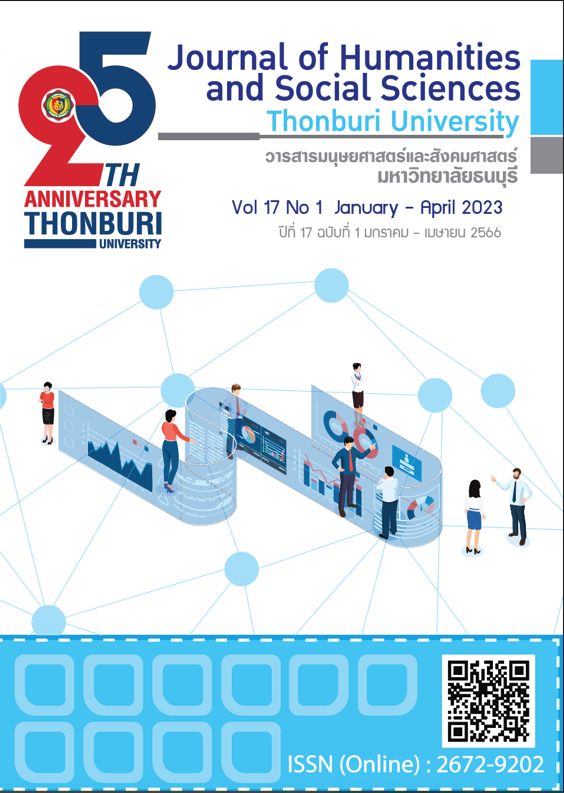โครงสร้างของทักษะคนคุณภาพ ในอุตสาหกรรมอาหารทะเลแปรรูปของไทย
Main Article Content
บทคัดย่อ
อุตสาหกรรมอาหารทะเลแปรรูปในประเทศไทยกำลังเปลี่ยนผ่านสู่อุตสาหกรรม 4.0 และอุตสาหกรรมประเภทนี้กำลังเผชิญกับความไม่สอดคล้องระหว่างทักษะแรงงานที่มีและทักษะที่ต้องใช้ในโลกการทำงาน ดังนั้นการศึกษานี้มีวัตถุประสงค์เพื่อ1) ตรวจสอบความเชื่อมั่นและความเที่ยงตรงของโมเดลโครงสร้างทักษะคนคุณภาพในอุตสาหกรรมอาหารทะเลแปรรูป และ 2) ตรวจสอบความสอดคล้องกลมกลืนของโมเดลโครงสร้างทักษะคนคุณภาพในอุตสาหกรรมอาหารทะเลแปรรูปกับข้อมูลเชิงประจักษ์ ใช้การวิจัยเชิงปริมาณ กลุ่มตัวอย่างเป็นคนคุณภาพ 360 คนของอุตสาหกรรมชั้นนำด้านอาหารทะเลแปรรูปในภาคใต้ กลุ่มตัวอย่างเลือกแบบเจาะจง เก็บข้อมูลใช้แบบสอบถามแบบปลายปิดมาตรวัดของลิเคิร์ท ผลการศึกษา พบว่า ความเชื่อมั่นเชิงโครงสร้าง และความเที่ยงตรงเชิงโครงสร้างอยู่ระหว่าง 0.74-0.91 และ0.57-0.79 โมเดลโครงสร้างทักษะคนคุณภาพในอุตสาหกรรมอาหารทะเลแปรรูปของไทยสอดคล้องกลมกลืนกับข้อมูลเชิงประจักษ์ c2= 607.96, df= 357, c2/df=1.70, RMSEA=0.044, SRMR=0.043, GFI = 0.90, CFI=0.99 และ NFI=0.97 และค่าน้ำหนักองค์ประกอบมีนัยสำคัญทางสถิตที่ระดับ 0.05 ทุกองค์ประกอบ สำหรับการนำไปใช้ประโยชน์หุ้นส่วนต่าง ๆ ในอุตสาหกรรมอาหารทะเลแปรรูปมีกรอบทักษะคนคุณภาพ เพื่อปรับใช้กับการพัฒนาทักษะแรงงานในอุตสาหกรรมประเภทนี้ ซึ่งสามารถลดปัญหาความไม่สอดคล้องของทักษะแรงงานและส่งเสริมความสามารถในการแข่งขัน
Article Details

This work is licensed under a Creative Commons Attribution-NonCommercial-NoDerivatives 4.0 International License.
ผลงานที่ปรากฎในวารสารฉบับนี้เป็นลิขสิทธิ์เฉพาะส่วนบุคคลของผู้เขียนซึ่งต้องรับผิดชอบต่อผลทาง กฎหมายที่อาจเกิดขึ้นได้และไม่มีผลต่อกองบรรณาธิการReferences
กรมส่งเสริมอุตสาหกรรม. (2558). ก้าวใหม่ กรมส่งเสริมอุตสาหกรรม. สืบค้นเมื่อ 9 กุมภาพันธ์ 2564, จาก https://www.dip.go.th/.../883f7ad6a4b1f09aaf1dd0b4189d7ac4.pd.
ชนาภา ศรจิตติโยธิน. (2564). ทักษะแรงงานโลกใหม่ พัฒนาก่อนไทยตกขบวน. สืบค้นเมื่อ 30 เมษายน 2565, จาก https://www.bangkokbiznews.com/business/972650.
ยุวดี จันทะศิริ. (2563). รูปแบบความสัมพันธ์เชิงสาเหตุลักษณะคนคุณภาพและการนำคนคุณภาพไปใช้ประโยชน์ที่มีต่อความยึดมั่นผูกพันและผลการปฎิบัติงานอขงพนักงานในอุตสาหกรรมอาหารทะเลแปรรูปภาคใต้: การวิจัยผสานวิธี. ปรัชญาดุษฎีบัณฑิต, มหาวิทยาลัยศรีนครินทรวิโรฒ.
สำนักงานส่งเสริมวิสาหกิจขนาดกลางและขนาดย่อม. (2558). สสว รับมอบนโยบายส่งเสริม SMes พร้อมเดินหน้างานปี 2559. สืบค้นเมื่อ 10 มกราคม 2564, จาก http://www.sme.go.th/th/index.php/news1/1015-smes-2559
สุวิมล ติรกานันท์ (2555). การวิเคราะห์ตัวแปรพหุในงานวิจัยทางสังคมศาสตร์. กรุงเทพฯ: โรงพิมพ์แห่งจุฬาลงกรณ์มหาวิทยาลัย.
เสาวณี จันทะพงษ์ และกัมพล พรพัฒนไพศาลกุล. (2562). การยกระดับทักษะแรงงานไทย: โจทย์ใหญ่ในยุคเทคโนโลยีเปลี่ยนโลก. สืบค้นเมื่อ 30 มกราคม 2565, จาก https://www.bot.or.th/Thai/ResearchAndPublications/DocLib_/Article_20 Feb2019.pdf
Asian Development Bank. (2021). Reaping the benefits of industry 4.0 through skills development in VIET NAM. Retrieved January 25, 2021, from https://www.adb.org/sites/default/files/publication/671921/benefits-industry-skills-development-viet-nam.pdf
Aulbur, W., CJ, A., & Bigghe, R. (2016). Whitepaper: Skill Development for Industry 4.0. Retrieved Fabruary 10, 2021, from http://www.globalskillsummit.com/Whitepaper-Summary.pdf
Chuantian, H., Baranchenko, Y., Lin, Z., Szarucki, M., & Yukhanaev, A. (2020). From Global Mindset to International Opportunities the Internationalization of Chinese SMEs. Journal of Business Economics and Management, 21(4): 967-986.
Comrey, A. L., & Lee, H. B. (1992). A first course in factor analysis. 2nded.. Hillsdale, NJ: Lawrence Erlbaum Associates.
Deloitte. (2018). Preparing tomorrow’s workforce for the Fourth Industrial Revolution. Retrieved March 10, 2021, from https://www2.deloitte.com/content
Diamantopoulos, A., & Siguaw, J. A. (2000). Introduction to LISREL: A guide for the uninitiated. London: SAGE Publications, Inc.
Fadhila, D., Aitouche, S., & Aksa, K. (2020). Analysis of Human Skills in Industry 4.0. Retrieved January 10, 2021, from https://www.semanticscholar.org/paper/Analysis-of-Human-Skills-in
Farndate, E., Scullion, H., & Sparrow, P. (2010). The role of the corporate HR function in global talent- management. Journal of World Business, 45 (2): 161-168.
Fornell, C., & Larcker, D.F. (1981). Evaluating Structural Equation Models with Unobservable Variables and Measurement Error. Journal of Marketing Research, 18(1): 39-50.
Gallardo-Gallardo, E., Dries, N., & Gonzalez-Cruz, T. F. (2013). What is the meaning of ‘talent’ in the world of work?. Human Resource Management Review, 23(1): 290-300.
Gallardo-Gallardo, E., Thunnissen, M., & Scullion, H. (2019). Talent management: context Matters. The International Journal of Human Resource Management, 31(4): 457 – 473.
Hair, F.J., Black.C., Babin. J.B., & Anderso. E.R, (2010). Multivariate Data Analysis: A Global Perspective. 7thed. Upper Saddle River, NJ: Prentice-Hall.
Hecklau, F., Galeitzke, M., Flachs, S., & Kohl, H. (2016). Holistic Approach for Human Resource Management in Industry 4.0. Procedia CIPR, 54: 1-6.
Holtonlll (Eds.). Research in organization: Foundations and methods of inquiry, (pp. 45-56). San Francisco, CA: Barrrett-Koehler Publisher Inc.
Hu, L-T., & Bentler, P.M. (1999). Cutoff criteria for fit indexes in covariance structure analysis: Conventional criteria versus new alternatives. Structural equation modeling, 6(1): 1-55.
Human Capital, Employment, and Human Resource Configurations. Journal of Management, 28: 517-543.
Karacay, G. (2018). Talent Development for Industry 4. In Pham, D.T. (Ed.). Industry 4.0: Managing: The Digital Transformation, (pp. 123-134). Birmingham: springer.
Kline, R. B. (2005). Principles and Practices of Structural Equation Modeling. (2th ed.). New York: Guilford Lepak, D. P., & Snell, S., A. (2002). Examining the Human Resource Architecture: The Relationships Among
Nunnally, J. C., & Bernstein, I. H. (1994). Psychometric Theory. (3rd ed.). New York: McGraw-Hill.
Passmore, D.L. & Bakker, R.M. (2005). Sampling strategies and power analysis. In R.A. Swanson & E.F.
People Measure. (2011). Defining and Measuring High Potential. Retrieved January 10, 2021, from https://www.peoplemeasures.com.au/
Ping, R.A. (2009). IS there any way to improve average variance Extracted in a Latent Variable . Retrieved April 10, 2021, from http://www..att.net.
Scottish Government Social Research. (2008). Skills Utilization Literature Review: Education Analytical Services, Life Long Learning Research, Scottish Government. Retrieved January 10, 2021, from https://dera.ioe.ac.uk/ 9416/1/0075479.pdf.
Wollenberg, A., Lazarini, J. J.C., & Rizal, M. R. (2020). Key Factors Contributing to the Development of the Global Mindset of Managers Using PLS-SEM. Journal of Economics, Business and Management, 8(3): 144-150.
World Economic Forum. (2016). The Future of Jobs: Employment, Skills and Workforce Strategy for the Fourth Industrial Revolution. Retrieved May 10, 2021, fromhttp://www3.weforum.org/docs/WEF_ Future_of_Jobs.pd.
Translated Thai References
Chantapong, S., & Pohnpattanapaisankul, K. (2019). Enhancing Thai Labor Skills: A Big Challenge in the World-Changing Technology Era. Retrieved January 30, 2022, from https://www.bot.or.th/Thai/ResearchAndPublications/DocLib/Article_20Feb2019.pdf. (in Thai)
Chunthasiri,Y. (2020). Characteristics of talent and talent utilization effect on employee engagement and performance in the seafood processing industry in southern Thailand: mixed methods research. (Doctoral dissertation, Srinakharinwirot University). (in Thai)
Department of Industrial Promotion . (2015). A new step of Department of Industrial Promotion. Retrieved February 9, 2021, from https://www.dip.go.th/.../883f7ad6a4b1f09aaf1dd0b4189d7ac4.pd. (in Thai)
SMEs Promotion. (2015). SMEs promotion accepts a policy to promote SMEs. Retrieved January 10, 2021, from http://www.sme.go.th/th/index.php/news1/1015-smes-2559. (in Thai)
Sornjittiyotin, Chanapa. (2021). New world skills developed before Thailand falls. Retrieved April 30, 2022, from https://www.bangkokbiznews.com/business/972650. (in Thai)
Tirakanant, S. (2012). Mutivariate Analysis Techniques in Social Science Research. Chulalongkorn University Press. (in Thai)

